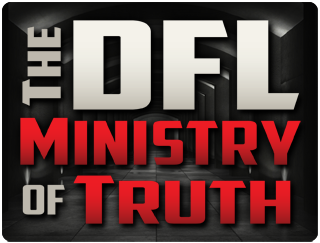Long before the Trayvon Martin shooting started dominating the headlines, gun law reform was in the news in Minnesota, and had already spawned a smaller, more “Barney-Fife”-y version of the disinformation mill that has been sweeping the nation these past few weeks.
Usually, whether the issue passes (like concealed carry) or not, it dies down between the final passages/vetos and the next session – because none of the people who write for the other side really know much about the issue other than what they’re told.
The Martin shooting has extended the disinformation season even here in Minnesota, though, as the DFL and media try to find a wedge issue to get their base frothed up and to try to peel off the uninformed, not-very-curious ones part of the swing set – the ones voted for Mark Dayton in 2010.
It’s an inflammatory statement. Let’s see if he packs the factual gear to follow it up:
Whichever. He’s setting himself up as an expert..
Odd that he doesn’t favor the reader with the name of the “group” with which he “consults”. I’m tempted to wonder if it’s “Protect Minnesota”, whose leader, Heather Martens, may be among the most discredited lobbyists on the hill – because she so habitually lies. If so, that might be why Weyandt doesn’t give us the name of the group. I’ll check up on that.
Back to Weyandt, the “expert” on gun law (and workmen’s comp!): he’s gotten his first key fact wrong.
So what’s wrong with Minnesota’s proposed Castle Doctrine bill?
Most important is the fact that there is no duty to retreat in a person’s home if someone enters illegally. That has been the major factor expressed by many in support of the proposal — “Come into my house and you’re toast.”
Pretty scary, huh?
Sounds like a pretty damning indictment of “Stand Your Ground”, doesn’t it? The idea that Minnesotans would lose the “Duty to Retreat”, while in their homes?
Except that it seems to have escaped the “expert” Mr. Weyandt, Esq. that Minnesotans have not had a duty to retreat when in their homes – between the front and back doors – for almost thirteen years. .
It’s not in the state statute. It’s in case law:
Case: State v. Carothers
Issue: Defense of dwelling, duty to retreat
Court: Minnesota Supreme Court
Cite: C8-98-86
Date: June 17, 1999
Link: http://www.lawlibrary.state.mn.us/archive/supct/9906/c89886.htm
Decision: A duty to retreat does not attach to defense
of dwelling claims.
So why does Weyandt, the “expert”, not relate this fact?
There are really two reasons this could happen:
- He doesn’t know what he’s talking about, and he’s letting it show.
- He’s trying to shape a reality in his audience’s mind’s eye that furthers his goal, which isn’t the same as telling the truth. LIke a prosecutor trying to make sure his “Jury” – the MinnPost audience – hears only the bits of information that he wants them to see, and none of the inconvenient facts that lead them away from his desired conclusion, he’s counting on his audience’s ignorance to make his case for him.
He’s not done. Not by a long shot:
The proposal — sponsored by Rep. Tony Cornish, R-Good Thunder, and Sen. Gretchen Hoffman, R-Vergas — would have allowed for the use of deadly force without a duty to retreat in a great many places other than a person’s home.
Why doesn’t Weyandt specify what the “Great Many” are?
Either because he’s incompetent, or he doesn’t want to “pollute” the argument with the fact that “the person’s property, outbuildings, vehicle or business” just aren’t and will never be a “great many” places; it’s small list indeed.
Which reason – incompetence, or a considered desire to mislead the public about the law – do you think Weyandt is exhibiting?
It also allowed a person to use deadly force if they reasonably feared harm. The proposal contained a provision that creates a presumption that the fear is reasonable. Current law requires the use of the reasonable-man standard and leaves the question up to the jury.
This paragraph is a dog’s breakfast of nonsense.
There’s an omission – from incompetence or via deception, again, and we have no idea – that presumes the fear of death or great bodily harm is reasonable “in the case of a person entering a dwelling or occupied vehicle by stealth or force”. That’s a rather more limited set of circumstances than Mr. Weyandt seems to want you to think, now, isn’t it?
Beyond that, and speaking to the lack of integrity in Mr. Weyandt’s piece? The law today allows a person to claim a homicide is justifiable if they “reasonably” fear death or great bodily harm. Here’s the law, as it is today. See the word? It’s right there!
The difference – the only difference – is that under the circumstances covered in the proposal, in the home or vehicle or property or business, which is being entered by force or stealth, the county prosecutor will have to prove that the fear of death or harm was unreasonable, rather than the shooter having to prove it (at their own expense, with a lengthy jail term hanging over their head should they not prove themselves innocent after an admission of “guilt with an explanation”).
That’s it!
Whether someone’s fear is reasonable is something a jury can understand.
And there’s the point of view of the professional attorney speaking.
A jury – sitting in a nice, warm, well-lit room, protected by sheriff’s deputies, with coffee breaks and donuts and bathroom time, can certainly determine that. But the jury also has to operate on information shaped by the way two lawyers – one of them a county prosector, working the case full time on the taxpayers dime, sitting in another nice, warm, safe, well-lit office, without, say, rapists beating down his door. He’ll have the luxury of time to try to persuade the jury, not that a woman’s fear of death or disfigurement wasn’t legitimate, but that she didn’t try hard enough to retreat from that threat to satisfy his picayune reading of the law. And if her attorney, charging her $250, can’t convince the county’s full-time attorney that that undefined “duty to retreat” was met, then she’s going to jail, even with her legitimate fear of death.
And that is the status quo that Weyandt – and Jim Backstrom, and at the end of the day Mark Dayton – are defending; the idea that a law-abiding citizen’s freedom hangs on a technicality to be decided by a bunch of lawyers.
Like Mr. Weyandt.
Cornish’s bill wasn’t a “shoot first” law. It was a “prosecutors have to earn their pay, or at least playing rhetorically-onanistic and politically-motivated games with peoples’ lives, when the shooting is so obviously law-abiding that even a lawyer other than Mr. Weyandt could see it”.
Lamentably, that doesn’t roll off the tongue quiet as fast.
Proving beyond a reasonable doubt that it was not reasonable, as the proposed law would have required, would seem to be nearly impossible.
This is pure fantasy.
Walk through this list of cases – mostly fictional, all plausible. They’ll show the “near impossibility” of a reasonably intelligent cop and prosecutor telling the difference between legitimate self-defense and murder, with or without the Cornish proposal.
Will some cases be more complicated than my examples? Sure; the Martin case is one of them (at least in terms of information available to the public. There may be cases – few, indeed – where the circumstances force prosecutors to work to get their precious conviction.
There might be a reason for that; it just might be that the shooting was perfectly legitimate.
So far, I’m guessing “reading Weyandt’s book” would be a bigger handicap to prosecutors than Cornish’s proposal.
The Cornish/Hoffman proposal allowed the use of deadly force if someone is threatened with substantial bodily harm (SBH). The law defines that as including a temporary disfigurement. That means a punch to the face and a black eye would allow the use of deadly force.
This is unvarnished bullshit, and Minnesota law says so.
Substantial bodily harm is “bodily injury which involves a temporary but substantial disfigurement, or which causes a temporary but substantial loss or impairment of the function of any bodily member or organ․
Go have a look for yourself. It’s not exactly beach reading – but it’ll show you that under Minnesota law, Weyandt is talking nonsense. A moderately-thorough scour through the cases didn’t find a single black eye among ’em.
Let me know how you do.
There are a couple of other especially troubling provisions:
• The expanded Castle Doctrine proposal would have granted total immunity from criminal prosecution.
They’re granted “total” immunity provided that the shooting was fully legal! Read the law yourself (jump down to line 6.16)
• The proposal did not allow the arrest of the suspect until police have fully considered any claim of self-defense.
I’ve often wondered about people who object to this provision, which basically says “if the shooting was of someone who was entering a house/vehicle/property by force, and there was reasonable fear of death or substantial harm, and the force was reasonable, and every other part of the law was upheld, feel free not to arrest the shooter”. That’s it.
Mr Weyandt’s desire to put people in handcuffs even if they are so obviously within the law that it’s transparently obvious to the cops borders on the unseemly.
So, if the police can’t arrest a suspect and bring him or her in for questioning, they have very little to no ability to determine if the person was acting in self-defense or not. If the police can’t develop evidence that the claim of self-defense is false, there can be no prosecution.
Wait – is Mr Weyandt saying that, even in cases where the facts aren’t relatively obvious, that the best or only source of information is an interrogation after arrest?
If there is a prosecution, the proposal would presume the belief that the fear of harm was reasonable…
…if the circumstances of the shooting were those covered in the law! If the shooter reasonably feared death or sufficient harm, and were on their property/in their car or business, and if the “victim” was entering one of those places via force or stealth to commit a crime!
It’s just not that difficult – provided the cops and prosecutors are modestly competent.
Despite all my criticisms, I am not among those who think such a law would create an increased danger to police. Nor do I believe that it would result in shootings all over the place.
What I do know, though, is that this proposal virtually would have negated the ability to prosecute anyone who applies deadly force under virtually any circumstance.
Provided they were utterly incompetent.
And on, and on, and on.
The entire piece relies on two things, really:
- Studiously misstating the context and effects of Cornish’s proposal
- Ignoring Minnesota case law.
As such, it stands alongside the rest of of the long-debunked “Protect Minnesota” propaganda that this blog has been shredding for a decade.
Here’s a special invitation to my lawyer friends to pick apart Mr. Weyandt’s argument. Use all the comment space you want. Hell, email me; I’ll print it as a post.
Because humiliating this brand of partisan disinformation from the front page of the Minnesota Media would be a wondrous public service.





